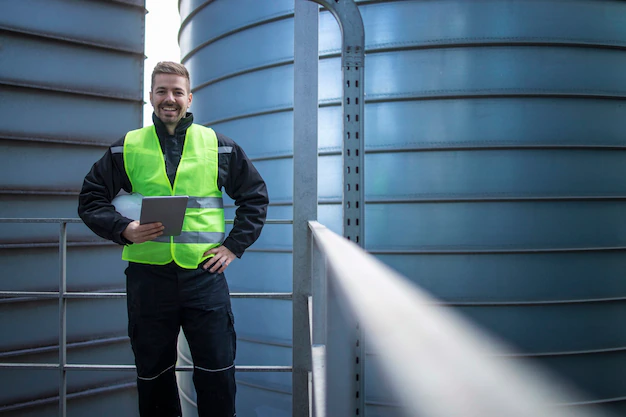
With technological advancements taking over various industrial sectors, water storage management is no different.
This article dives deep into understanding modern water tanks’ types, their specific applications, the innovative trends shaping the industry, and more. Now, whet your appetite for knowledge as you plunge into this realm.
Water Tank Importance
Beyond storing water for daily usage, water tanks play an integral role in emergencies such as droughts and fires where groundwater might become scarce or contaminated. They also reduce dependency on public water supply systems, saving energy and demarcating self-sustenance.
Rainwater collection in tanks can immensely aid agricultural activities, especially in regions where rainfall is scanty and erratic. Further, using collected rainwater for non-potable uses decreases the demand on municipal water supplies significantly.
Water Tank Types
The industry gives people a plethora of choices when it comes to types of water tanks. There are polyethylene or plastic tanks known for their lightweight and cost-effectiveness; steel tanks that score high on durability; slimline tanks, ideal for small spaces; and many more.
Each type suits a different need based on the available space for installation, the climate conditions of the area, the required capacity of storage, and budget restrictions. Click here to visit the complete range offered on this site.
Rainwater Tanks and Technology
Modern technology has skewed towards using rainwater harvesting systems due to their eco-friendliness. Collected rainwater can be used for irrigation, flushing toilets, washing vehicles and clothes – essentially reducing the strain on municipal resources considerably.
By installing filters at inlet pipes and using UV sterilization techniques for purification processes, you can ensure a safe potable water supply for years to come. Technologies like rain-to-mains switches are also being employed, letting you switch to mains water supply when tank water is running low.
Industrial Tank Usage
Industrial water tanks possess high capacity and are often used for processes requiring significant volumes of water. They are crucial components in areas such as fire protection systems, irrigation, horticulture, livestock rearing, and even commercial vehicle cleaning businesses.
Materials used for these tanks range from fiberglass and steel to concrete and coated fabric, depending on the scale of need. Systems with automatic control panels capable of monitoring water levels are prevalent in the industry.
Polyethylene Water Tanks
Available in sizes ranging from 100 liters to a substantial 30,000 litres, polyethylene tanks meet the water storage needs of households as well as factories. Their corrosion-resistant quality suits coastal areas prone to rusting. As BPA-free and food-safe UV-resistant plastic, these tanks safely provide drinking water. Their durable built-in strength helps them withstand harsh weather for years without cracking or warping.
Steel Water Tanks
Think strength – think steel. Steel water tanks promise exceptional strength and durability. These heavy-duty variants are resistant to punctures, cuts or cracks – obstacles that usually cripple other tank types.
Coupled with inherent resistance to UV radiation and harsh weather conditions significantly increases their longevity compared to their peers. Stainless steel varieties also prevent rusting and algae growth within the tank, thereby guaranteeing clean water every time you open the tap.
Rural Water Tank Solutions
Rural environments typically require larger capacities due to extensive reliance on stored water for agriculture and livestock. Concrete and steel tanks are a common sight due to their higher capacities and robustness under harsh, rural geographical conditions.
Incorporating features such as automated fill systems and installing multiple tanks to function in tandem can provide efficient rural water management solutions. These setups ensure a consistent supply of clean water for consumption and irrigation throughout the year.
Slimline Water Tanks
Slimline tanks, with their sleek design, accommodate limited space making them perfect for urban residences. They can be fit snugly along wall spaces or fences without incurring much of the property’s footprint.
Despite their small stature, these tanks can store large water volumes efficiently owing to their well-distributed weight design. Thus, delivering a great storage capacity without needing ample space – making every drop count indeed!
Getting Acquainted with Specifications
Before investing in a water tank, grasp key specifications like capacity, diameter, height, weight, inlet positioning, outlets, warranty period, and material thickness. Wall thickness hugely impacts durability – thicker lasts longer. Understanding the exact construction materials indicates if water will stay contamination-free.
Capacity and Size Options
When choosing a water tank, prioritizing storage capacity is wise. For residential purposes, tanks with capacities from 100 to 50000 liters might suffice your needs. However, for commercial or industrial uses large-capacity tanks are more favorable.
Size and shape matter significantly depending upon the available installation area. Vertical tanks save ground footprint while horizontal or slim-line tanks can fit in smaller spaces effectively.
Climate Considerations
Climate plays an instrumental role in defining the longevity of your water tank. For areas prone to high temperature or sunlight exposure, UV-resistant tanks would be ideal to prevent algae growth and water contamination.
In cold climate regions, polyethylene or insulated steel tanks prevent water from freezing. In windy regions use of anchorage kits for securing tanks is a must.
Maintenance and Durability
Regular maintenance is critical to ensure water quality and tank longevity. Flushing the tank periodically, cleaning filters and monitoring for potential leaks or malfunctions help maintain optimal performance.
Durability primarily depends on the material quality, wall thickness, and environmental factors. While metal tanks may last longer, they may require additional treatments to resist corrosion. Plastic tanks are naturally corrosion-resistant but can have a reduced lifespan in harsh climates.
The Eco-Friendly Aspect
Water tanks contribute significantly to conserving water, thereby making them an environmentally friendly option. Rainwater tanks help in reducing the dependence on mains water supply thus leading to significant savings of water resources. Calculating rainwater catchment at Water Tank Factory shows the potential.
We should also aim towards materials like recyclable polyethylene that cause negligible damage to the environment. Stainless steel tanks too are completely recyclable thus offering an eco-friendly alternative.
Innovations in Water Tanks
Exciting new innovations drive progress in water tank functionality. Internet-connected smart tanks with embedded sensor systems can self-monitor water levels, track daily usage, detect leaks early, and analyze long-term patterns via cloud-syncing apps. Solar water heating integration helps households lower grid energy consumption as well. Researchers also continually improve polymer materials to increase future tank durability using green chemistry techniques.
Water tanks form an integral backbone helping both households and industry become more water self-sufficient and sustainable. With rainfall increasingly unpredictable in a changing climate, stored reserves buffer variability.
Whether looking to harvest rainwater or store municipal supplies, selecting the optimal tank to meet needs counts among the wisest investments. New advances improve access to clean water globally while reducing environmental impact – innovations set to transform lifestyle and business operations well into the coming decades.
The Final Wrap
Water storage tanks empower self-reliance and ecological responsibility across many facets of life. As climate change intensifies, protecting access to clean, safe water grows more crucial than ever. With knowledge of the range of options available today and how different tanks suit distinct needs, both families and industry can take control.
Implementing water conservation technology remains one of the most effective tools we have to build resilience. Whether relying on the rains or municipal supply, water tanks form the foundation from which to face the coming decades. Through innovation, we stretch each drop further in pursuit of sustainability.
Read Also:






